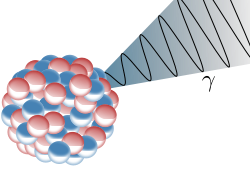What Are Gamma Rays?

Gamma-rays have the smallest wavelengths and the most energy of any other wave in the electromagnetic spectrum. These waves are generated by radioactive atoms and in nuclear explosions. Gamma-rays can kill living cells, a fact which medicine uses to its advantage, using gamma-rays to kill cancerous cells.
Gamma radiation is very high-energy ionizing radiation. Gamma photons have about 10,000 times as much energy as the photons in the visible range of the electromagnetic spectrum. Gamma photons have no mass and no electrical charge — they are pure electromagnetic energy. Because of their high energy, gamma photons travel at the speed of light and can cover hundreds to thousands of meters in air before spending their energy. They can pass through many kinds of materials, including human tissue. Very dense materials, such as lead, are commonly used as shielding to slow or stop gamma photons.
When an atom undergoes radioactive decay, it emits one or more forms of radiation with sufficient energy to ionize the atoms with which it interacts. Ionizing radiation can consist of high speed subatomic particles ejected from the nucleus or electromagnetic radiation (gamma-rays) emitted by either the nucleus or orbital electrons.
|